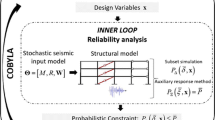Abstract
This paper addresses the optimal design problem of added damping in framed structures. Interstory performance indices for linear and nonlinear structures are chosen and restricted to allowable values under the excitation of an ensemble of realistic ground motion records. Optimality criteria are formulated based on fully stressed characteristics of the optimal solution, and a simple analysis/redesign procedure is proposed for attaining optimal designs. Results of four examples presented compare well to those obtained using formal gradient-based optimization.
Similar content being viewed by others
References
Bannon H, Biggs JM, Irvine HM (1981) Seismic damage in reinforced concrete frames. J Struct Div 107(ST9):1713–1729
Carr AJ (2001) RUAUMOKO—program for inelastic dynamic analysis. Department of Civil Engineering, Christchurch
Cilley FH (1900) The exact design of statically indeterminate frameworks, an exposition of its possibility but futility. Trans ASCE 42:353–407
Constantinou MC, Tadjbakhsh IG (1983) Optimum design of a first story damping system. Comput Struct 17(2):305–310
Fu Y, Kasai K (1998) Comparative study of frames using viscoelastic and viscous dampers. J Struct Eng 124(5):513–522
Gluck N, Reinhorn AM, Gluck J, Levy R (1996) Design of supplemental dampers for control of structures. J Struct Eng 122(12):1394–1399
Haskell G (2003) Rehabilitation of a 1985 steel moment-frame building. Earthq Spectra 19(2):385–397
Inaudi JA, Kelly JM, To CWS (1993) Statistical linearization method in the preliminary design of structures with energy dissipating devices. Proc, ATC-17–1 Seism Isol, Passive Energy Dissipation Act Control 2:509–520
Khot NS, Berke L (1976) Structural optimization using optimality criteria method. In: Atrek A, Gallagher RH, Ragsdell KM, Zienkiewicz OC (eds) New directions in optimum structural design, pp 47–74
Kim J, Choi H, Min KW (2003) Performance-based design of added viscous dampers using capacity spectrum method. J Earthqu Eng 7(1):1–24
Lavan O, Levy R (2005a) Optimal design of supplemental viscous dampers for linear framed structures. Earthq Eng Struct Dyn (in press)
Lavan O, Levy R (2005b) Optimal design of supplemental viscous dampers for irregular shear frames in the presence of yielding. Earthq Eng Struct Dyn 34(8):889–907
Levy R (1985) On the optimal design of trusses under one loading. Q Appl Math 43(2):129–134
Levy R (1991) Fixed point theory and structural optimization. Eng Optim 17(4):251–261
Levy R, Lavan O, Rutenberg A (2005) Seismic design of friction damped braced frames based on historical records. Earthq Spectra (in press)
Lopez-Garcia D (2001) A simple method for the design of optimal damper configurations in MDOF structures. Earthq Spectra 17(3):387–398
Miyamoto HK, Scholl RE (1996) Case study: seismic rehabilitation of non-ductile soft story concrete structure using viscous dampers. In: Proceedings of the Eleventh World Conference on Earthquake Engineering, Acapulco, Mexico. Elsevier, Paper No. 315
Park YJ, Ang AHS (1985) Mechanistic seismic damage model for reinforced concrete. J Struct Eng 111(4):722–739
Rozvany GIN (1989) Structural design via optimality criteria: the Prager approach to structural optimization (mechanics of elastic and inelastic Solids). Kluwer Academic Publishers, Dordrecht
Shen KL, Soong TT (1996) Design of energy dissipation devices based on concept of damage control. J Struct Eng 122(1):76–82
Somerville P, Smith N, Punyamurthula S, Sun J (1997) Development of ground motion time histories for phase 2 of the FEMA/SAC steel project. Report No. SAC/BD-97/04
Soong TT, Dargush GF (1997) Passive energy dissipation systems in structural engineering. Wiley, Chichester
Spillers WR (1975) Iterative structural design. North Holland Publishing Company, Amsterdam
Takewaki I (1997) Optimal damper placement for minimum transfer function. Earthq Eng Struct Dyn 26(11):1113–1124
Takewaki I, Yoshitomi S, Uetani K, Tsuji M (1999) Non-monotonic optimal damper placement via steepest direction search. Earthq Eng Struct Dyn 28(6):655–670
Tso WK, Yao S (1994) Seismic load distribution in buildings with eccentric setback. Can J Civ Eng 21:50–62
Uang CM, Bertero VV (1990) Evaluation of seismic energy in structures. Earthq Eng Struct Dyn 19(1):77–90
Uriz P, Whittaker AS (2001) Retrofit of pre-Northridge steel moment-resisting frames using fluid viscous dampers. Struct Des Tall Build 10:371–390
Venkayya VB (1978) Structural optimization: a review and some recommendations. Int J Numer Methods Eng 13:203–228
Williams MS, Sexsmith RG (1995) Seismic damage indices for concrete structures: a state-of-the-art review. Earthq Spectra 11(2):319–349
Wu B, Ou JP, Soong TT (1997) Optimal placement of energy dissipation devices for three-dimensional structures. Eng Struct 19(2):113–125
Zhang RH, Soong TT (1992) Seismic design of viscoelastic dampers for structural applications. J Struct Eng 118(5):1375–1392
Author information
Authors and Affiliations
Corresponding author
Rights and permissions
About this article
Cite this article
Levy, R., Lavan, O. Fully stressed design of passive controllers in framed structures for seismic loadings. Struct Multidisc Optim 32, 485–498 (2006). https://doi.org/10.1007/s00158-005-0558-5
Received:
Revised:
Published:
Issue Date:
DOI: https://doi.org/10.1007/s00158-005-0558-5




